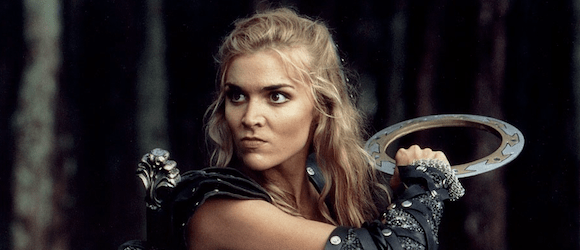If you’ve seen an episode of Xena, hell, if you’ve seen the opening titles to Xena, you know that you don’t mess with Xena. She’s strong, clever, resilient, and at times, ruthless. The show remains an important feminist text for a number of reasons, reasons reinforced by the likes of Joss Whedon and Quentin Tarantino. It champions strong women, but at the same time, it does not paint them as these infallible, flat superheroines. The female characters of the show, allies and villains alike, are rounded, with complex back-stories and goals that range from trying to lift a city-wide ban on dancing to wanting to become the queen of the Amazons.
But this is old news. What’s really striking about the show is just how many of the central villains are female. To date, I believe Xena still has the most female big-bads of any television show.
To clarify, I would classify a big-bad as a villain who is a formidable opponent to the protagonist—someone who could match her at every turn, and, occasionally, overpower and outsmart her. A big-bad should also have a large role, either throughout a season arc or within the show’s entire run. She should not play second string to anyone, though she can be involved in another villain’s evil plot. Ultimately, she should have her own goals.
Xena has many formidable enemies, many of whom are women, and the most intriguing of whom is her archnemesis, Callisto. Callisto is a woman bent on destroying everything that crosses her path, particularly Xena, who was responsible for the slaughter of Callisto’s family when she was just a child. Callisto is a personification of Xena’s sins, of what her past actions as a ruthless warlord wrought, and how they twisted a young, innocent girl into a sadistic psychopath. Callisto’s is a compelling story, and it reinforces a recurring theme within the show—that Xena is not the only female with power, that there is a large pool of strong women in the world she inhabits, and that extends to the villains of that world.
We all know why it’s important to see women inhabit positions of power in popular media. These figures serve as role models for young women to aspire to. They also break widely-held stereotypes about what a woman’s role should be and what a woman is capable of doing. It’s just as important to have female villains as it is to have female protagonists, and this is perhaps doubly important in a show that has a female protagonist at its center, because it shows that these heroes come from a community of strong women and that an empowered woman is the norm as opposed to an isolated incident. Giving Xena a female archenemy that is every bit the warrior she is, pitting her against other female villains who are capable of besting her, shows that Xena is not an exception. She is not the one woman amongst the thousands who is capable of wielding such strength; she is one of the many (though, there’s only one Warrior Princess). Other genre shows that have showcased universes not only populated by strong female protagonists, but antagonists as well are Buffy the Vampire Slayer (Glorificus, Faith), Angel (Drusilla, Darla), Once Upon a Time (Regina), Battlestar Galactica (early Six (arguably), and all of the female cylons for that matter), and Elementary (Irene Adler/Moriarty).
While there have been several popular female heroines over the past few decades, female villains, short of the aforementioned and the ones that fall into the diminutive tropes of the femme fatale or the seductress, are typically secondary characters working for or on a lower tier than the “real big-bad.” This brand of villain is rarely much of a threat in the grand scheme of things. They function as a small hindrance to the protagonist, a hiccup on their way towards a bigger battle, and they almost always provide a side-serving of scantily clad eye-candy for the viewer.
The caliber of these female villains is significant. It’s important to have female villains that transcend the trope of the femme fatale and do more than just look pretty beside their male boss—a villainess who’s more than an errand girl and doesn’t get pacified by a bigger, eviler male antagonist. We need more female villains that have their own agency, their own intricate back-story, and their own twisted vision of what the world would look like if they were on top. The type of villain who can flip the script, torch it, and serve its charred remains to the heroine while she frantically tries to figure out which way is up. So, I ask (you know, since I haven’t seen every show ever made), where my female villains at?
Tamar Altebarmakian is a writer whose ultimate wish in life is to record the words, “Previously, on (insert name of show currently obsessed with here).”








Published: Jul 17, 2013 04:19 pm